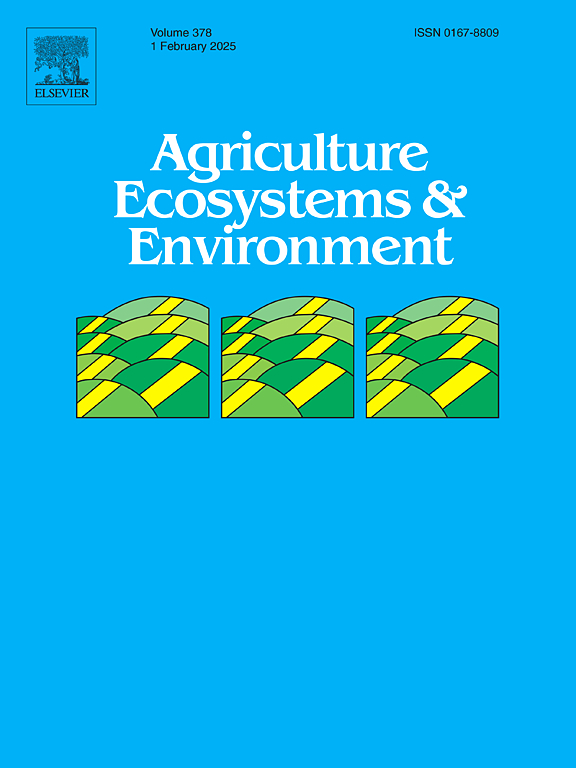Shifts in water use in grapevine due to an invasive sap-feeding planthopper persist following insect removal
IF 6
1区 农林科学
Q1 AGRICULTURE, MULTIDISCIPLINARY
引用次数: 0
Abstract
Increasing outbreaks of invasive insect pests pose a substantial threat to the functioning and viability of cultivated and wild woody perennial species worldwide. In the eastern U.S., the spotted lanternfly (Lycorma delicatula White; SLF), an invasive phloem-feeding planthopper, was reported to be able to negatively impact late-season plant carbon dynamics in various woody perennial species following repeated or prolonged infestation and feeding events. However, it remains unclear if SLF infestations also impact plant water relations and if SLF-mediated effects persist when populations are controlled and feeding stops. This study investigated how late-season exposure to SLF impacts whole-plant water relations by assessing diurnal sap flow and trunk radius changes in grapevines subjected to varying infestation densities of adult SLF. In two seasons, vines exposed to high infestation densities (an average of 180 SLFs per vine) for up to 31–32 days of cumulative SLF exposure had significantly lower sap flow rate than those with no SLF, resulting in up to 38 % less daily total water use. Trunk diurnal amplitudes increased under SLF infestation, but impacts were less dependent on infestation density, suggesting that grapevines may be utilizing trunk water storage during infestation to meet both grapevine water use and SLF sap ingestion. In both cases, SLF-mediated effects persisted following removal of SLFs, suggesting that exposure to high populations of SLF can alter patterns of late-season grapevine water use, at least when populations are not effectively controlled. These results indicate that SLF can modify both whole-plant water relations and carbon dynamics concurrently, further defining the implications that intensive infestations by high populations of SLF have for woody perennial whole-plant physiology.
移除入侵的食液蝇导致的葡萄树用水量变化在除虫后依然存在
入侵害虫的日益爆发对全球栽培和野生多年生木本植物的功能和生存能力构成了巨大威胁。据报道,在美国东部,斑灯蝇(Lycorma delicatula White;SLF)是一种入侵的噬茎害虫,在反复或长期侵袭和取食后,会对各种多年生木本植物的晚季植物碳动态产生负面影响。然而,SLF 的侵扰是否也会影响植物的水分关系,以及当种群数量得到控制并停止取食后,SLF 介导的影响是否会持续,目前仍不清楚。本研究通过评估不同成虫密度的葡萄树的昼夜液流和树干半径变化,研究了晚季暴露于SLF对整个植物水分关系的影响。在两个季节中,葡萄树暴露于高侵染密度(平均每株葡萄树 180 个 SLF)下长达 31-32 天的累积 SLF 暴露,其树液流动速率明显低于无 SLF 的葡萄树,导致每日总用水量减少达 38%。在SLF侵扰下,树干昼夜振幅增大,但对侵扰密度的影响较小,这表明葡萄树可能在侵扰期间利用树干储水来满足葡萄用水和SLF树液摄取。在这两种情况下,移除 SLF 后,SLF 介导的影响仍会持续,这表明大量接触 SLF 会改变晚季葡萄树的用水模式,至少在种群未得到有效控制的情况下是如此。这些结果表明,SLF可同时改变整个植株的水分关系和碳动态,进一步明确了高种群SLF的密集侵染对多年生木本植物整个植株生理的影响。
本文章由计算机程序翻译,如有差异,请以英文原文为准。
求助全文
约1分钟内获得全文
求助全文
来源期刊

Agriculture, Ecosystems & Environment
环境科学-环境科学
CiteScore
11.70
自引率
9.10%
发文量
392
审稿时长
26 days
期刊介绍:
Agriculture, Ecosystems and Environment publishes scientific articles dealing with the interface between agroecosystems and the natural environment, specifically how agriculture influences the environment and how changes in that environment impact agroecosystems. Preference is given to papers from experimental and observational research at the field, system or landscape level, from studies that enhance our understanding of processes using data-based biophysical modelling, and papers that bridge scientific disciplines and integrate knowledge. All papers should be placed in an international or wide comparative context.
 求助内容:
求助内容: 应助结果提醒方式:
应助结果提醒方式:


